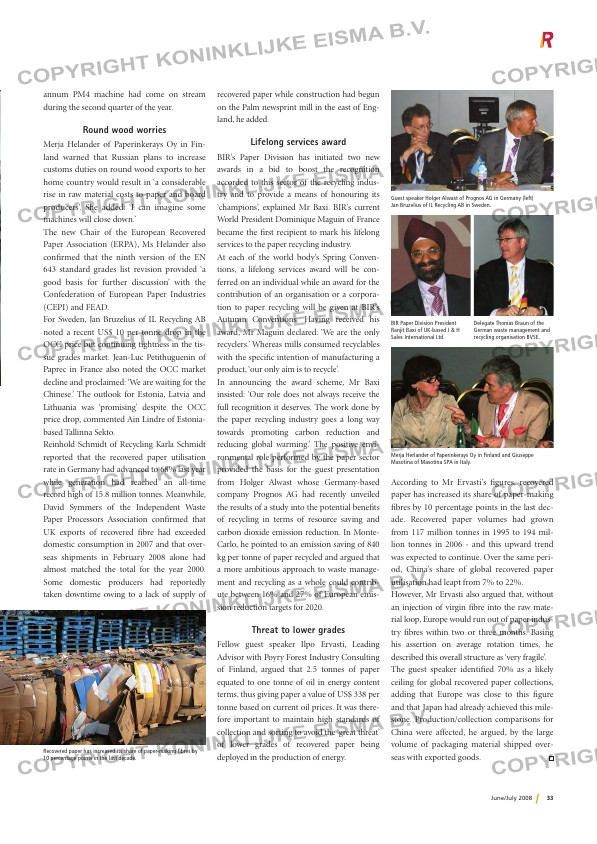Page 33 from: June / July 2008

33June/July 2008
annum PM4 machine had come on stream
during the second quarter of the year.
Round wood worries
Merja Helander of Paperinkerays Oy in Fin-
land warned that Russian plans to increase
customs duties on round wood exports to her
home country would result in ‘a considerable
rise in raw material costs to paper and board
producers’. She added: ‘I can imagine some
machines will close down.’
The new Chair of the European Recovered
Paper Association (ERPA), Ms Helander also
confi rmed that the ninth version of the EN
643 standard grades list revision provided ‘a
good basis for further discussion’ with the
Confederation of European Paper Industries
(CEPI) and FEAD.
For Sweden, Jan Bruzelius of IL Recycling AB
noted a recent US$ 10 per tonne drop in the
OCC price but continuing tightness in the tis-
sue grades market. Jean-Luc Petithuguenin of
Paprec in France also noted the OCC market
decline and proclaimed: ‘We are waiting for the
Chinese.’ The outlook for Estonia, Latvia and
Lithuania was ‘promising’ despite the OCC
price drop, commented Ain Lindre of Estonia-
based Tallinna Sekto.
Reinhold Schmidt of Recycling Karla Schmidt
reported that the recovered paper utilisation
rate in Germany had advanced to 68% last year
while generation had reached an all-time
record high of 15.8 million tonnes. Meanwhile,
David Symmers of the Independent Waste
Paper Processors Association confi rmed that
UK exports of recovered fi bre had exceeded
domestic consumption in 2007 and that over-
seas shipments in February 2008 alone had
almost matched the total for the year 2000.
Some domestic producers had reportedly
taken downtime owing to a lack of supply of
recovered paper while construction had begun
on the Palm newsprint mill in the east of Eng-
land, he added.
Lifelong services award
BIR’s Paper Division has initiated two new
awards in a bid to boost the recognition
accorded to this sector of the recycling indus-
try and to provide a means of honouring its
‘champions’, explained Mr Baxi. BIR’s current
World President Dominique Maguin of France
became the fi rst recipient to mark his lifelong
services to the paper recycling industry.
At each of the world body’s Spring Conven-
tions, a lifelong services award will be con-
ferred on an individual while an award for the
contribution of an organisation or a corpora-
tion to paper recycling will be given at BIR’s
Autumn Conventions. Having received his
award, Mr Maguin declared: ‘We are the only
recyclers.’ Whereas mills consumed recyclables
with the specifi c intention of manufacturing a
product, ‘our only aim is to recycle’.
In announcing the award scheme, Mr Baxi
insisted: ‘Our role does not always receive the
full recognition it deserves. The work done by
the paper recycling industry goes a long way
towards promoting carbon reduction and
reducing global warming.’ The positive envi-
ronmental role performed by the paper sector
provided the basis for the guest presentation
from Holger Alwast whose Germany-based
company Prognos AG had recently unveiled
the results of a study into the potential benefi ts
of recycling in terms of resource saving and
carbon dioxide emission reduction. In Monte-
Carlo, he pointed to an emission saving of 840
kg per tonne of paper recycled and argued that
a more ambitious approach to waste manage-
ment and recycling as a whole could contrib-
ute between 16% and 27% of European emis-
sion reduction targets for 2020.
Threat to lower grades
Fellow guest speaker Ilpo Ervasti, Leading
Advisor with Poyry Forest Industry Consulting
of Finland, argued that 2.5 tonnes of paper
equated to one tonne of oil in energy content
terms, thus giving paper a value of US$ 338 per
tonne based on current oil prices. It was there-
fore important to maintain high standards of
collection and sorting to avoid the ‘great threat’
of lower grades of recovered paper being
deployed in the production of energy.
According to Mr Ervasti’s fi gures, recovered
paper has increased its share of paper-making
fi bres by 10 percentage points in the last dec-
ade. Recovered paper volumes had grown
from 117 million tonnes in 1995 to 194 mil-
lion tonnes in 2006 – and this upward trend
was expected to continue. Over the same peri-
od, China’s share of global recovered paper
utilisation had leapt from 7% to 22%.
However, Mr Ervasti also argued that, without
an injection of virgin fi bre into the raw mate-
rial loop, Europe would run out of paper indus-
try fi bres within two or three months. Basing
his assertion on average rotation times, he
described this overall structure as ‘very fragile’.
The guest speaker identifi ed 70% as a likely
ceiling for global recovered paper collections,
adding that Europe was close to this fi gure
and that Japan had already achieved this mile-
stone. Production/collection comparisons for
China were affected, he argued, by the large
volume of packaging material shipped over-
seas with exported goods.
Delegate Thomas Braun of the
German waste management and
recycling organisation BVSE.
BIR Paper Division President
Ranjit Baxi of UK-based J & H
Sales International Ltd.
Guest speaker Holger Alwast of Prognos AG in Germany (left)
Jan Bruzelius of IL Recycling AB in Sweden.
Merja Herlander of Paperinkerays Oy in Finland and Giuseppe
Masotina of Masotina SPA in Italy.
Recovered paper has increased its share of paper-making fi bres by
10 percentage points in the last decade.
RI_017 BIR Paper.indd 33 19-06-2008 16:20:04



